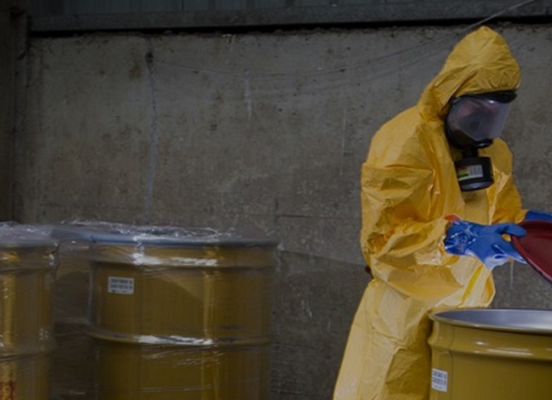Hazardous chemical waste is defined as any substance that poses a health threat to humans or could cause damage to the environment, if not managed correctly. Chemical waste can be generated by many sources, ranging from chemical laboratories and industrial manufacturing to the disposal of household batteries or cleaning fluids. It comes in many physical forms and could be a solid, sludge, liquid or gas, or a combination of these forms. As a rule of thumb, a chemical is considered to be hazardous if it’s flammable at temperatures below 60°C (140°F); or if it is corrosive, and has a pH lower than 2 or higher than 12.5. It will also be classed as hazardous if it is unstable, explosive, or reacts violently with water; or if it is toxic and could harm people or the local ecosystem.
It’s imperative to manage chemical waste correctly, to ensure the safety of your workforce, and comply with regulations. Poorly managed chemical waste can contaminate our water streams, impacting both aquatic and human life. The following guide outlines an approach organization can take to limit chemical waste and best practices in chemical waste management.
Minimize the use of hazardous chemicals
Safer chemical alternatives are continually being developed to replace hazardous chemicals, so businesses are increasingly able to reduce their usage. Always opt-for the least hazardous and costly-to-handle materials, and choose the purest, non-corrosive raw materials. If there aren’t any less hazardous alternatives available, then make sure you only use the minimum amounts required, re-use as many chemicals as possible, recycle all recoverable materials, and then dispose of any remaining hazardous substances.
Inventory Management and Control
Effective hazardous waste management requires strict inventory control. Inventory limits should always be set according to your emergency response capacity. Using inventory management software to manage your chemical stocks will make the process easier and help ensure you don’t order too much or little of any chemical. It will also help keep track of the shelf life of materials, so older stock is always used first. Storage conditions should be maintained at the optimum temperature and humidity to prevent degradation – this information can be found on the Material Safety Data Sheets (MSDSs) supplied with all hazardous chemicals.
Preventing spills and maximizing material usage
Consider whether the design of your site is optimized for waste reduction. Are the distances between storage and work areas are as short as they could be? Or are there are any potentially dangerous impediments on the route between these areas? Efficient production scheduling, to ensure chemicals are only taken from storage when they’re going to be used, will also help mitigate the risk of leaks and spills. Minimizing the need to transfer materials into different containers, and using pre-weighed packages to reduce handling requirements, will also help reduce the risk. If you are using large quantities of a hazardous chemical, consider buying bigger containers, so the total number of containers for disposal or refilling is reduced. Plus, you should always use chemical containers that are wider than they are tall, as they are not only more stable; they also collect less residue, resulting in greater material usage.
Chemical waste recycling
When chemicals are recycled, the useful materials that can’t be directly re-used, and would otherwise be discarded, are recovered, collected, and separated from the chemical waste, significantly reducing the amount of waste that needs to be treated and discarded. Hazardous waste recycling can be carried out on-site, with the recycled materials being returned to a manufacturing process within the same facility, or waste can be collected and the recycling carried out off-site, by a licensed third-party.
Chemical waste disposal
While lots of chemical waste can be safely and effectively recycled, other chemical waste will need to be treated and disposed of correctly. Hazardous chemical waste treatment is carried out at dedicated Treatment Storage and Disposal Facilities (TSDFs). Read this blog to learn more about the various ways in which chemical waste can be treated. To prevent chemical waste from accumulating at your premises, take regular advantage of local hazardous waste collections; and by properly segregating your waste in your on-site chemical waste storage area, you can remove the risk of cross-contamination.
In summary
Reducing the production of hazardous chemical waste is a goal that should be shared by all organizations wishing to benefit from a safer and more compliant workplace. If you want to learn more about safe chemical recycling and disposal, contact the Enva chemical waste management team today.
To know more, please check Enva.

